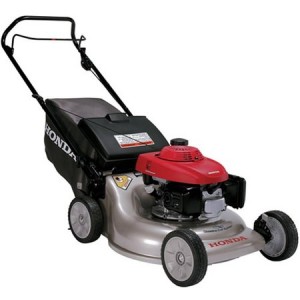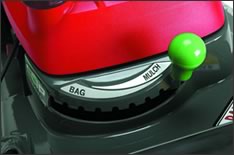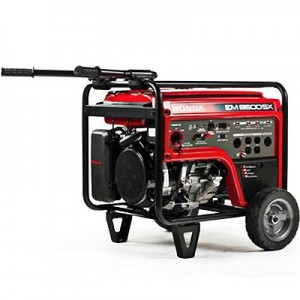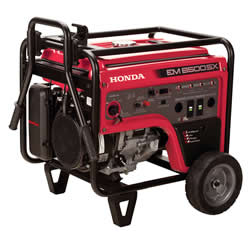The HRR216PKA is Honda’s least expensive mower, making it the most common choice for homeowners new to the brand. Despite its price, it still offers all the innovation you expect from Honda, which makes using it different from anything else from the market. Here’s how you can get the most out of this unique mulching mower.
Using the Clip Director
Unlike most walk-behind mowers, the PKA has a rear-mounted discharge chute. The Clip Director, located next to the base of the handle, operates a door that can cover this chute. This eliminates the need for a mulch plug.
To change mowing modes, push in the button and move the lever to either “Bag” or “Mulch.” If you want to discharge clipping without mulching them, set the Clip Director to “Bag.” Clippings will be sent out of the rear discharge chute without being re-cut.
Cutting Height
Height is set by moving the levers next to each of the wheels. With the levers moved all the way toward the rear of the mower, the cutting height is 1 1/8 inches. Adjustment isn’t linear: as the levers are moved forward, the cutting height increases to 1 ¾, 2 ½, 3, 3 ½ and finally 4 inches.
Fuel
The engine used in this mower is designed to use gasoline that contains up to 10% ethanol. This fuel should be used within 30 days of purchase, or within 90 days if it’s treated with a fuel stabilizer. When adding fuel, only fill the tank up to the bright red fuel lever gauge inside the filler neck. After filling the tank, move the mower away from the fueling location. This prevents the ignition of any remaining fuel vapor.
Smart Drive Control
The mower’s self propulsion is controlled by pushing on the palm pads of the smart drive control: the harder you push, the faster the mower will go. Letting up on these pads shuts off the drive system, letting you push the mower when maneuvering around trees and other obstacles.
To adjust the position of the Smart Drive Control, move the adjustment lever on the back of the controls to the left to unlock. Rotate the controls until they’re in a comfortable position, then move the adjustment lever to the right to lock them in place.
If the drive system isn’t engaging like it should check the cable tension. With the engine off, then put the drive control levers in their lowest position. Push down on the levers while rolling the mower backward. The mower should stop before the levers are pointed straight down. If it doesn’t stop, find the adjuster, located between the bottom of the handle and the mower. Loosen the jam nut. It may be helpful to mark one side of the long adjuster nut. Pull the mower backward without using the Smart Drive Control. If you don’t feel resistance, turn the adjuster nut clockwise one turn. Keep rolling the mower and turning the adjuster until the mower wheels lock up when pulling the mower backward. Turn the adjustment nut counterclockwise 8 times and tighten the lock nut.
Microcut Blades
The Microcut system uses two blades stacked on top of each other. The upper blade is narrow with an angled cutting edge, while the lower blade has large winged ends to increase vacuum.
To access the blades, tilt the mower on its right side so the fuel tank is facing up. This keeps fuel from flooding the carburetor.
When fitting blades to your mower, the upper and lower blades should be stacked on top of each other, followed by a set of directional washers and bolts. The outer edge of the washers should face toward the blades. Torque the blade bolts to 36-43 ft-lbs.
Grass Bag
To attach the bag, lift the guard on the back of the mower and set the bottom edge of the bag opening against the bottom of the discharge chute. Push the bag forward to lock it into place.
Over time, the pores in the bag can become clogged, keeping air from passing through and reducing the amount of grass entering the bag. If this happens, remove the bag from the mower and wash it with a garden hose or pressure washer. The grass bag can be used again once it’s completely dry.
Mowing on Hills
This mower is designed to handle slopes up to 20 degrees. When mowing on a hill, go across it instead of up and down.
Getting Parts for Your Honda Mower
Hondalawnparts.com is an authorized Honda Engines and Honda Power Equipment dealer, which means we carry everything you need to maintain your HRR216PKA mower. Our site can show you parts based on your model and serial number, and it even has built-in parts diagrams direct from the manufacturer, making it easy to find what you need. We ship across the US and Canada.





